
Table of contents
Transform Gmail into a simple and intuitive helpdesk!

How to Use Gmail as a Helpdesk: A Detailed Guide

Table of contents
A report by Forrester suggests that email continues to be the most popular way customers reach out to companies for help.
In a report by Salesforce, it was found that 64% of customers prefer to communicate with businesses through email.
With customer experience at the heart of building a successful business in the present day, the need to be “really good at managing customer emails” is pressing.
Interestingly, the email service that companies use will play a pivotal role in how well teams can serve customers. Customer service teams would need the ability to manage conversations efficiently, and at scale.
In this post, we’re discussing how to make Gmail, the fastest-growing email service provider for businesses, work as a customer service helpdesk.
Businesses of all shapes and sizes are going Gmail now. Axios reported in March 2020 that Google Workspace has more than 2 billion users now. Compared to 1.5 billion users in 2018, this is a massive increase in its popularity.
With email being a popular choice for customers to talk to companies — combined with the ever-growing popularity of Google Services such as Google ads, Google Chrome, Google Groups, and Google Cloud — the world definitely needs a flawless (and reliable) way of managing customer emails via Gmail.
But, is Gmail really geared to handle customer conversations?
Let’s dive in and find out.
Table of Contents
- How Gmail fares at managing customer conversations
- Standalone helpdesk tools: Yay or Nay?
- Hiver helps you deliver brilliant customer service from Gmail
- How teams across industries deliver great customer service with Hiver
- Try out Hiver
How Gmail fares at managing customer conversations
There’s a common saying in support circles: The best experiences are delivered by teams that work together – and help each other.
Naturally so, while managing customer service, it’s important that your support reps collaborate with ease. But, the unfortunate truth about Gmail, and every other email client for that matter, is that they were designed to be used by individuals.
Every time your support team uses a shared Gmail account (support@ or help@) to manage customer conversations, teamwork suffers, resolution slows down, and you leave customers unhappy.
Allow us to explain this better.
1. Delegating emails breeds clutter (and inefficiency)
The usual way most customer support teams work: an email arrives — the manager or supervisor delegates it to an agent/rep — they start working on it. Delegation is an everyday task for support teams.
The problem is — with Gmail, the only way you can delegate an email to someone — is by forwarding it. The problem with forwards is that they unnecessarily clutter everyone’s inboxes. Not just that, most emails you forward are forwarded again and more teammates keep getting Cc’d.
The general rule of thumb is – the fewer email addresses you involve in a thread, the faster things move.
2. Building ownership for emails is tough
The best way to handle customer requests quickly is to assign every email to an “individual” — to have one person on the team “own” the email, and take it to execution.
Inside a shared Gmail account, it is virtually impossible to build ownership. Forwarding emails is not a structured way of assigning tasks. Accessibility is a pain and there’s always room for missed emails — especially when your team manages a large number every day.
When you use Gmail for managing customer service, you’d always wish there was something more powerful than forwarding to build ownership.
3. Collaboration is bumpy
Inside Gmail, working together with a teammate, or taking help from someone, can get chaotic quickly.
Say you’re working on a customer email and you need help.
For the lack of a better option, you forward the email to your teammate Justin.
Justin wants an opinion from a product engineer – and forwards the email to Simon.
Justin still keeps you in Cc so that you are in the loop.
Justin and Simon exchange a few emails before it finally comes back to you.
Now that’s a lot of internal emails, and it’s essentially slowing down the resolution process.
The general rule of thumb is to never write emails for internal discussions. It always gets messy.
4. Overseeing emails gets frustrating
Let’s say an agent handles an email and replies to the customer. Now, unless the agent has copied the support@ address in their reply, there is no way the rest of the team will know of it.
The only way you would know if an email has been resolved is by asking around your team. It’s certainly not the most efficient way of managing customer service.
5. Finding insights is straining
Customer service teams always need answers to a few fundamental questions, such as:
- What is the average time my team takes to reply to – or resolve an issue?
- Which type of problems takes more time than others to resolve?
- Who in my team is doing well and who needs a little coaching?
You’d want a bit of analytics and reporting to answer these questions. But Gmail does not offer any of that. To spot patterns in customer queries and resolutions, you’ll be forced to use manually intense spreadsheets.
At this stage, a lot of companies start looking for something better to manage their support emails.
And many end up resorting to standalone, external helpdesk software. But, does that really make things better? Let’s find out.
Recommended read: 7 Best Free Help Desk Software in 2024
Standalone helpdesk tools: Yay or Nay?
There’s a plethora of helpdesk tools out there that promise to make customer support a breeze.
But, they come with a steep compromise: you’ll have to step outside your Google account — into the tool’s ecosystem.
It’s always an entirely new way of managing emails. Teams are forced to change their behavior and adopt new habits. There is always a round of training involved.
And it doesn’t end there. Here are a couple more problems with standalone helpdesk tools:
1. Emails turn into (impersonal) tickets
Have you ever received an email with a subject line similar to “Re: CASE76543”?
Or a weirdly-formatted email that starts with “##please do not write below this line##”?
This is the age-old practice known as Ticketing. Most helpdesk tools turn customer emails into tickets that agents “resolve” in chronological order.
The problem with ticketing is that:
- Agents enter the mindset of resolving tickets (as opposed to having conversations with customers)
- Customers receive robotic-looking emails that address them as numbers (and not people)
- It takes away humanness from conversations – and teams just solve problems – instead of building relationships
2. The never-ending back and forth
There is no helpdesk software out there that does everything your inbox does. Your team will still have to keep going back to their inboxes — when emails don’t sync, or just to make sure that the replies have actually gone out.
The helpdesk tool will not have a central hub like typical inboxes where you see all your emails in one place. Most of your reps will have an “assigned to me” or “pending tasks” section that they’ll work from. For a holistic view of their inbox, they’d have to keep going back to Gmail.
The constant to and fro between the helpdesk tool and the inbox is distracting, to say the least. Your team will waste hours every day.
And, at that moment, you realize that you do not need a bulky software install to manage customer support. They only complicate managing emails.
It’s about time we took a step back. What if you could do everything a help desk tool promises to do without even leaving your inbox?
What if we could improve Gmail to function like a helpdesk — minus the complexities?
Hiver helps you deliver brilliant customer service from Gmail
Your agents anyway spend a whole lot of time in Gmail. Would it not make sense to manage customer emails from Gmail itself?
But wait, didn’t we just discuss the lapses of Gmail?
Okay, so there’s also this really good thing about Gmail: it’s fluidic. It can be tweaked. It’s actually just a few steps away from working stunningly well for customer service.
And that’s where Hiver comes in.
It adds a layer of functionality on top of Gmail — so that customer service teams can manage emails in a structured way, and also efficiently.
Here’s how your Gmail inbox changes shape with Hiver:
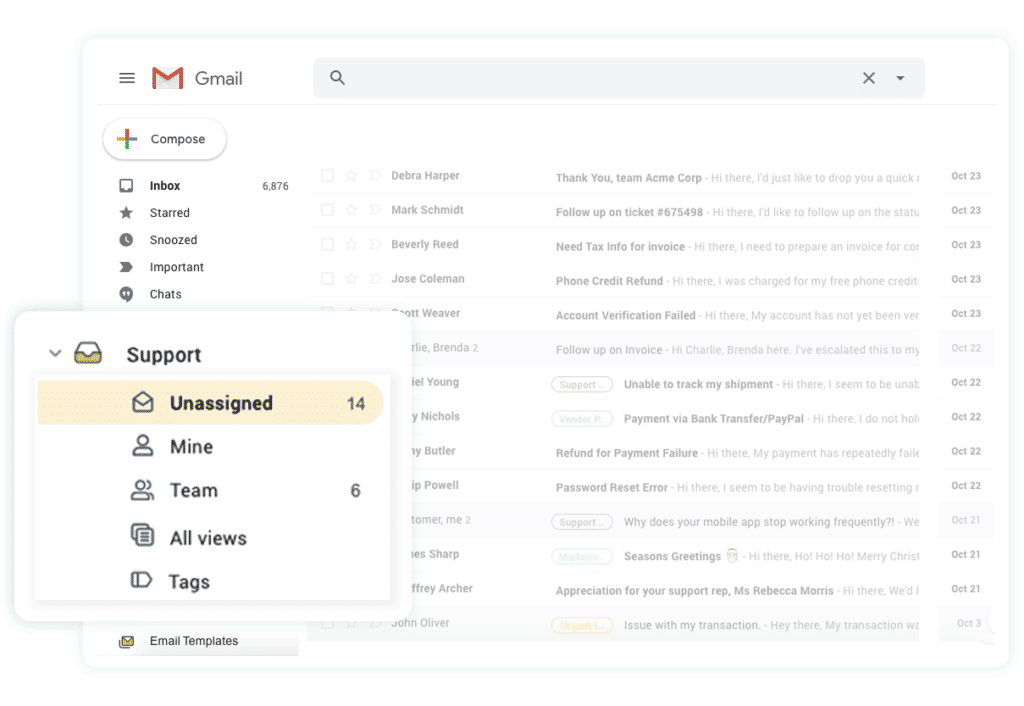
Notice how the support@ inbox becomes a part of Gmail?
Your team will be able to manage customer conversations right from their work inboxes. You can finally say goodbye to the constant switching between tools, and even tabs.
There’s a lot more:
1. Almost zero learning curve
Remember we talked about the extensive training before your team could start using customer service software? Well, that changes for good when you start using Hiver.
There is hardly anything to learn: no training guides, painful onboarding, long transition times, and the cognitive load of using a complex software for simple tasks. Your team will not have to adopt a new behavior for managing customer emails.
Anyone who’s comfortable with Gmail will find Hiver super easy to use. In fact, most teams get started in a few minutes.
Don’t just take our word for it. Virginia and her team at Reali moved to Hiver, and they love it.

2. Fostering ownership (never miss an email)
Hiver solves the haphazard delegation problem that is native to Gmail. It helps you assign customer emails and chats to your team in 2 clicks from Gmail.
(Your teammates can access – and reply to that email thread the moment you assign it to them. You do not have to Cc them.)
If manual assignment is a lot of work, you can set up conditions (sender’s email id, or subject line) and have emails assigned to your team automatically.
And, if you receive a lot of emails on a daily basis — and want to be 100% sure that every email gets picked up, you’d love “Auto Assignment.” It helps you assign every email to your team in a round-robin manner.
Here are the larger benefits of easy work assignment:
- Reps always know what they have to work on; your team is always on the same page. When team members know how things work on a day-to-day basis, it is easy for them to see the bigger picture. They feel more empowered and make better decisions.
- Managers can, in a glance, see who’s working on what and its status (Open, Pending, or Closed). Overseeing your team’s workflows becomes easier.
- No email ever goes unattended — which means no customer has to wait unreasonably long for an answer.

3. Faster behind-the-scenes collaboration
Helping customers is hardly ever a one-person show. Teams always need to come together to discuss complex customer issues or send the perfect response. Hiver understands this and helps team members collaborate faster around emails.
So, how can team members have fast internal discussions? With Notes. It helps agents have chat-style conversations – right next to email threads.
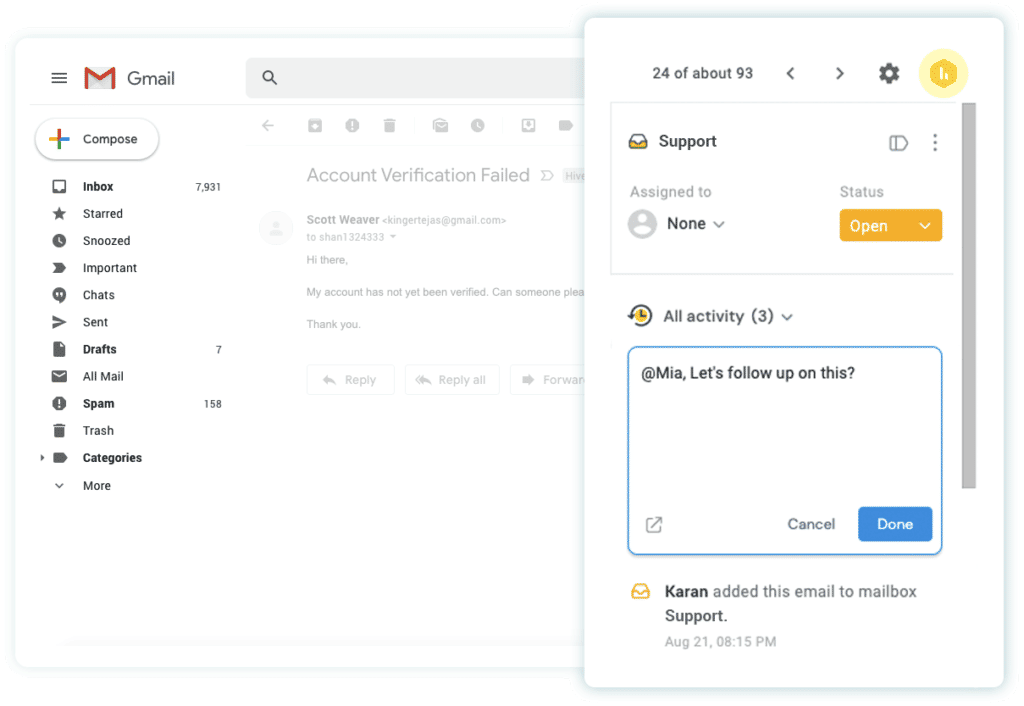
It also means no time spent in building the context for the next person. (When teams use messaging applications to discuss emails, building the story usually takes a lot of time.)
The other crucial aspect of collaboration within support teams: working together on email replies.
And how do team members help each other send great replies to customers?
- Shared Drafts helps agents work together on email replies in real-time, as opposed to back and forth emails (think: collaborating within Google Docs – it’s that simple).
- Email Templates can now be shared across the board (in case you’re wondering: Gmail’s canned responses cannot be shared across the team).
4. Remote-friendly
Amidst the pandemic, a large number of companies have started working from home. And it’s gradually becoming a popular culture. CNBC reports that remote work continues to be the norm for many organizations even as economies open. It’s pretty obvious now that remote work is here to stay.
While running customer service remotely, the one aspect you should look for: the help desk solution must help teams stay on the same page at all times.
And how does Hiver help here?
- Building ownership for emails is simple. Teammates are always aligned on who has to work on which request.
- Internal discussions are fast and contextual (with Notes). Team members don’t need to switch to chat applications.
- Team members can collaborate on email responses without back and forth emails.
- It is super intuitive for managers to oversee their team’s workflows (ownership and status of tasks, and email replies).
- Managers can quickly step in and help agents, even when they’re not Cc’d on emails.
You’d find this interesting

5. Human conversations (no impersonal tickets)
Hiver helps you do away with the support ticketing concept: there are no ticket numbers, no robotic-looking emails, no impersonal conversations.
Customer service teams must realize that their job is much more than just resolving tickets or solving problems. They are the face of the company. They are at the helm of maintaining relations. The way they make a customer feel — is the way customers will feel about the business. Interestingly, the helpdesk software they use can be a really good way to develop that mindset.
Hiver helps you have personal conversations with customers. All your customers see is a friendly email.
There are no weird-looking subject lines, the hideous “##please do not write below this line##,” or annoying auto-responders.
Just real human-to-human interactions.
6. Eliminate time-consuming work
It goes without saying that repetitive grunt work can affect the productivity of your agents. It eats up into their bandwidth and leave them very less time to focus on more complex tasks.
Harvey, Hiver’s AI bot is your trusty sidekick that takes care of those mundane, time-consuming tasks, allowing your agents to focus on what truly matters.
How does it do that?
Well, for starters, every time a customer sends out a ‘Thank You’ response after a conversation is marked close by an agent, the conversations gets reopened. Agents then have to manually close these conversations. Now, imagine having to do these over and over again for hundreds of customer conversations. Productivity definitely takes a huge hit.
Harvey counters this problem in a simple yet effective way. Equipped with a ‘Thank You Detection Feature’, Harvey is able to identify conversations that have an underlying ‘thank you sentiment’ and automatically closes these conversations, saving time and effort for your agents.
Harvey is also capable of analyzing customer conversations and offering intelligent suggestions on the best email template to choose when replying to a particular message. This helps you to easily reply to customer queries without missing a beat!
7. Keep support teams accountable
Research shows that 90% of customers rate an immediate response as very important when they have a customer service question.
Now, in order to deliver timely support, it is important for your support agents to know exactly what it means. Does it mean responding to a query in one hour? Or does it mean you need to respond in 24 hours?
This is where Hiver’s SLAs (Service Level Agreements) come in.
With Hiver you can configure and manage SLAs quite easily. It is an effective way to keep your customer support teams accountable and ensure that customer queries are resolved efficiently.
Hiver’s SLAs allow you to:
- Set SLA-based reminders to enable timely resolution of customer queries
- Prioritize queries based on their defined SLAs
- Configure different SLAs for different categories of customer issues
- Notify the concerned stakeholders before an SLA violation occurs.
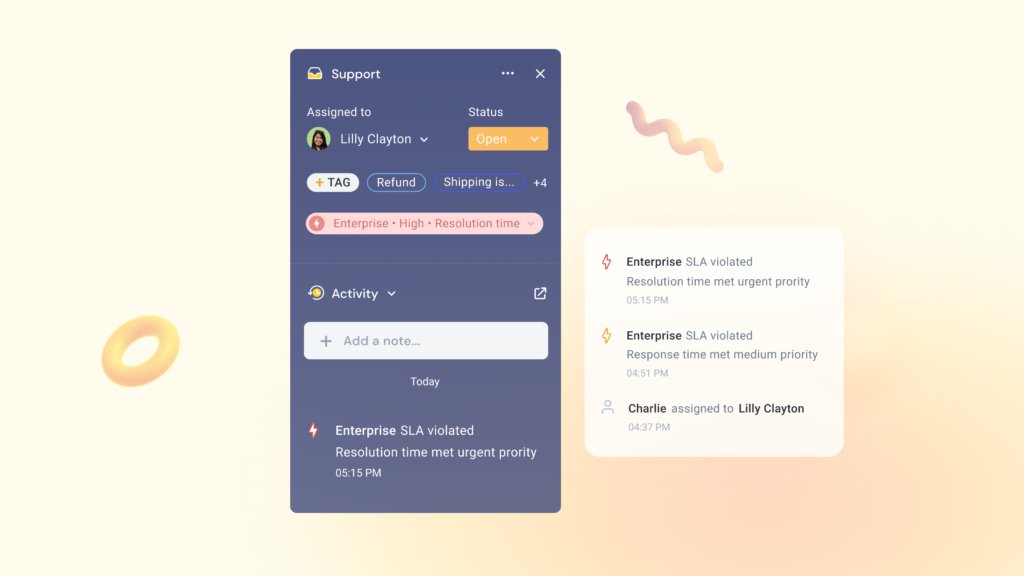
8. Provide real-time customer support
Live chat is a critical support tool for businesses. It enables customers to communicate with businesses in real-time and has, in fact, been shown to generate satisfaction levels of 73%, much higher than any other channel including phone support.
Hiver’s Live Chat offers you a seamless way to interact with your customers. It allows you to provide instant support to customers while reducing the burden on your support agents. It can be accessed right from Gmail – a tool your agents are already familiar with.
Apart from this, Live Chat also gives agents access to chat templates which have predefined responses for recurring support issues. Templates can help support agents respond faster to customer requests.
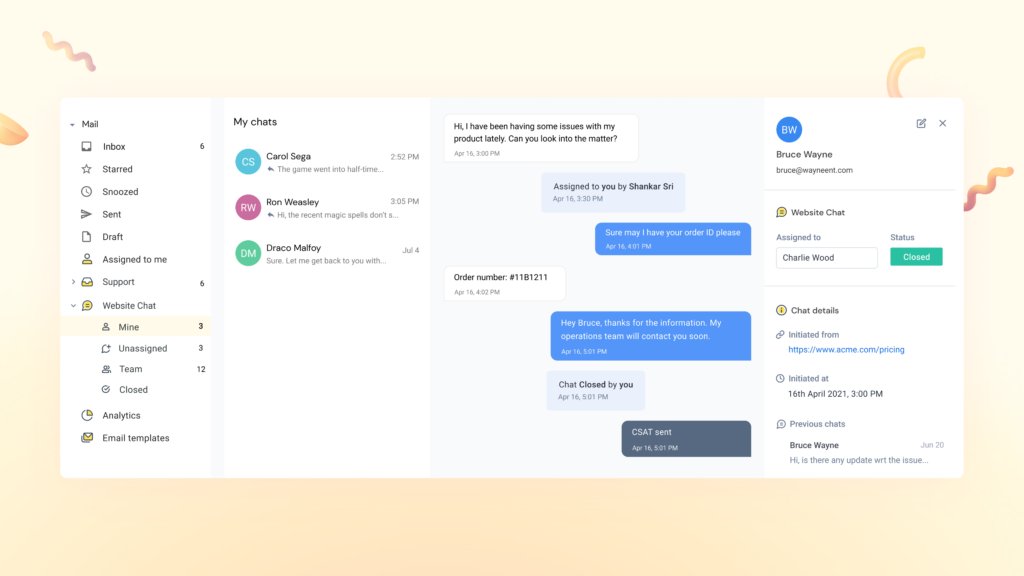
9. Enable customers to self-serve
Providing customers with options to self-serve their queries is a great way to keep your customers happy. On one hand customers are delighted since they don’t have to wait for an agent to step in and solve their query. They can do it all by themselves. On the other hand, self-service means that your support agents do not have to put out every fire which in turn improves their productivity and allows them to focus on more sophisticated tasks.
Hiver’s Knowledge Base is an elegant solution to empower customers to self-serve.
You can easily create help and support articles with this feature and build a centralized library of help articles, instructions, guides, FAQs, etc. that can be used by your customers any time. Besides, if your customers are not able to find answers to a specific query, they can create support tickets from inside the knowledge base.
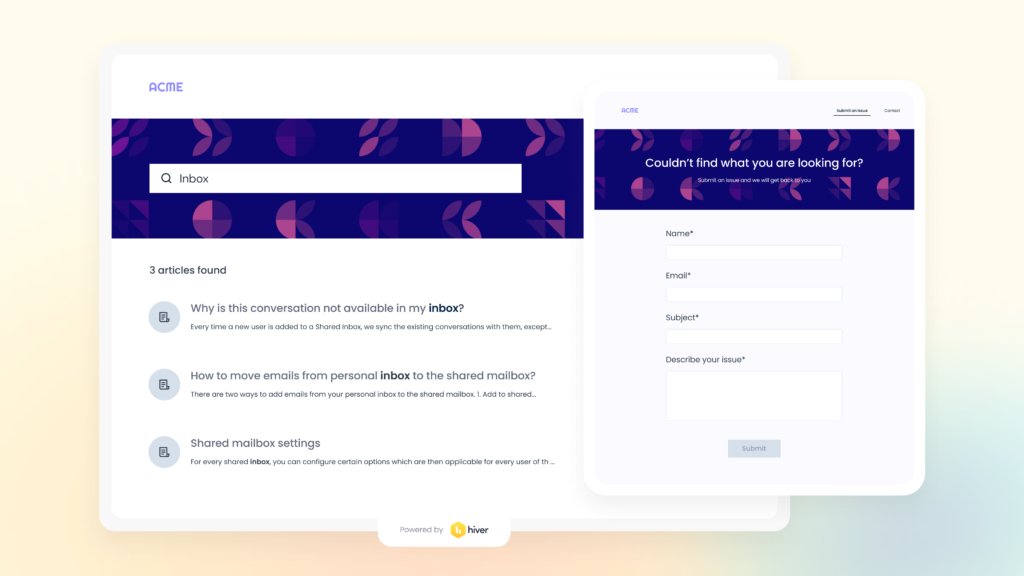
10. Simple (yet insightful) reporting
We don’t really have to emphasize how important performance tracking and reporting capabilities are in customer service.
Hiver helps you analyze and track your team’s performance with incredible ease — without even leaving Gmail. There are no complex terminologies or manually-intense spreadsheets involved.
Oh, simple does not mean superficial. You’d still have deep insights into team performance. You’ll have access to the most crucial customer support metrics, including:
- How many conversations have taken place, how quickly your team is responding to emails, and the average time taken by your team to resolve an issue.
- Aspects of individual team member performance: their overall workload, response and resolution times, and customer satisfaction scores.

11. Keep your data safe (Security by Google)
Emails can have all shades of sensitive information. When you manage customer emails, you have to be extremely careful about security. Even more so when your entire team could potentially have access to private customer data.
Hiver understands this and takes your customers’ privacy seriously. It is one of the few helpdesk solutions that does not store emails — they continue to be on Gmail’s servers.
Not just that; Hiver is:
- A certified Google Partner
- Compliant with EU – US Privacy Shield
- SOC 2 Type II Compliant
- ISO 27001 Certified
On a team level, you can create roles-based permissions — so that you restrict access to sensitive information to only those team members who need it.
How teams across industries deliver great customer service with Hiver
From Logistics, Financial Services, Healthcare, all the way to Travel — Hiver helps companies from all walks of life deliver great customer service from Gmail.
Here are a couple of stories of how customer-facing teams overcame the limitations of Gmail to deliver brilliant service:
1. Hiver helps Flexport resolve customer emails 50% faster

Flexport is a Softbank-backed freight forwarding and customs brokerage company based in San Francisco, California.
The challenge
Their team was using Gmail to manage customer conversations and was forced to forward emails to team members for assigning work.
Building ownership for emails was not easy that way, and there were frequent misses.
The solution
With Hiver, the customer service team at Flexport overcame the lapses of Gmail for good.
- They now assign emails with ease (no forwarding) and build ownership for each request. With every email accounted for, the team has stopped missing emails.
- Their manager has insights into team members’ performance: how many conversations they handle in a given time, the average time they take to resolve emails, and more.
- Team members collaborate faster without sending more emails or switching to chat applications.
2. Hiver helped Kiwi.com achieve a 100% SLA completion rate

Kiwi.com is a Czech online travel agency that works with customers across the globe. Presently, they are one of the five biggest online sellers of flight tickets in Europe.
The problem
The team was using Gmail lists to route incoming emails to members. Each incoming email was sent to every member’s individual inbox. Establishing who had to work on what was not easy.
At the same time, it was hard for David (the manager) to oversee his team’s workflow. He had no visibility into the ownership and status of emails.
As a result, the team sometimes missed the 24-hour SLA.
The solution
With Hiver, Kiwi.com turned their email lists into Shared Inboxes. It helps team members stay on the same page about what’s going on.
Okay, so here’s how Hiver’s shared inboxes fare against Gmail lists:
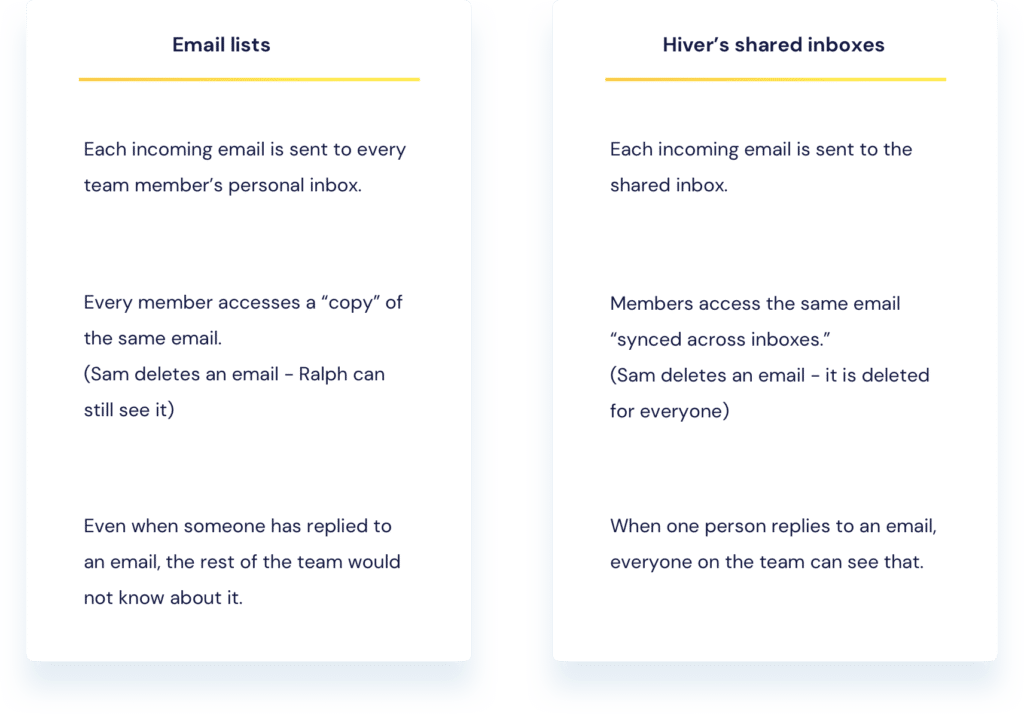
David and his team’s lives have become easier since they started using Hiver:
- With rule-based automations, emails are assigned to members with zero manual intervention.
- The entire team is always on the same page about who is working on what, and every email’s status.
- The time they used to spend establishing who has to work on an email — or the time David used to spend finding out the status of emails — is saved now.
Try out Hiver
Over 8000 customer service teams use Hiver to deliver brilliant customer support, including the likes of Harvard University, Lonely Planet, Hubspot, Oxford Business Group, Capterra, among others.
You can always sign up for a 14-day Free Trial to see if Hiver works for your team.




































